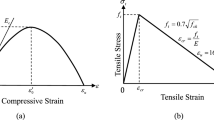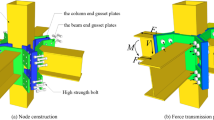Abstract
A nonlinear three-dimensional finite element model is employed to investigate the seismic performance and failure mechanism of a subway station. The interaction between subway station and surrounding soil is considered and the nonlinear behavior of the station structure is taken into account. Structural concrete and steel bars are simulated separately. The results demonstrated that the carrying capacities of structural middle columns and wall-to-roof slab connections are vital in underground structure’s seismic design. During an earthquake, the structure’s plastic damage first appears at beam-to-roof slab connections; but the damage at beam-to-roof slab connections does not develop significantly as seismic going. The heaviest damage parts is columns’ bottom, and then is columns’ top. The damage of wall-to-slab connections can, firstly, let the load transfer to columns and, secondly, reduce the restraint to the roof slab. The relative displacement between the roof slab and bottom slab leads to additional moment on structural middle columns. Besides, the damage at the connections of walls-to-diagonal bracings and slabs-to-diagonal bracings is remarkable. The structure is failure as an italic “M” shape. The results are consistent with the phenomena observed in the collapse of Daikai subway station during 1995 Great Hanshin Earthquake.
Similar content being viewed by others
References
Abdollahiparsa, H., Homami, P., and Khoshnoudian, F. (2016). “Effect of vertical component of an earthquake on steel frames considering soil-structure interaction.” KSCE Journal of Civil Engineering, Vol. 20, No. 7, pp. 2790–2801, DOI: 10.1007/s12205-016-0687-y.
An, X., Shawky, A. A., and Maekawa, K. (1997). “The collapse mechanism of a subway station during the Great Hanshin Earthquake.” Cement and Concrete Composites, Vol. 19, No. 3, pp. 241–257, DOI: 10.1016/S0958-9465(97)00014-0.
Çelebi, E., Celebi, E., Goktepe, F., and Karahan, N. (2012). “Non-linear finite element analysis for prediction of seismic response of buildings considering soil-structure interaction.” Natural hazards and earth system sciences, Vol. 12, No. 11, pp. 3495–3505, DOI: 10.5194/nhess-12-3495-2012.
Chaudhary, M. T. A. (2016). “Seismic response of bridges supported on shallow rock foundations considering SSI and pier column inelasticity.” KSCE Journal of Civil Engineering, pp.1–11, DOI: 10.1007/s12205-016-0352-5.
Chen, Q. and Li, W. (2015). “Effects of a group of high-rise structures on ground motions under seismic excitation.” Shock and Vibration, Vol. 2015, DOI: 10.1155/2015/821750.
Emadi, A., Shakib, H., and Shadlou, M. (2014). “Investigation of beneficial and detrimental effects of soil-foundation-structure interaction on the seismic response of shear buildings.” KSCE Journal of Civil Engineering, Vol. 18, No. 1, pp. 253–263, DOI: 10.1007/s12205-014-0202-2.
Ertugrul, O. L. (2016). “Numerical modeling of the seismic racking behavior of box culverts in dry cohesionless soils.” KSCE Journal of Civil Engineering, Vol. 20, No. 5, pp. 1737–1746, DOI: 10.1007/s12205-015-0235-1.
Gazetas, G., Gerolymos, N., and Anastasopoulos, I. (2005). “Response of three Athens metro underground structures in the 1999 Parnitha earthquake.” Soil Dynamics and Earthquake Engineering, Vol. 25, No. 7, pp. 617–633, DOI: 10.1016/j.solidyn.2004.11.006.
Hashash, Y. M. A., Hook, J. J., Schmidt, B., and Yao, I. C. (2001). “Seismic design and analysis of underground structures.” Tunnelling & Underground Space Technology, Vol. 16, No. 4, pp. 247–293, DOI: 10.1016/S0886-7798(01)00051-7.
Huo, H., Bobet, A., Fernández, G., and Ramírez, J. (2005). “Load transfer mechanisms between underground structure and surrounding ground: evaluation of the failure of the daikai station.” Journal of Geotechnical & Geoenvironmental Engineering, Vol. 131, No. 12, pp. 1522–1533, DOI: 10.1061/(ASCE)1090-0241(2005)131:12(1522).
Iida, H., Hiroto, T., Yoshida, N., and Iwafuji, M. (1996). “Damage to Daikai subway station.” Soils & Foundations, Vol. Jan, pp. 283–300.
Jarernprasert, S., Bazan-Zurita, E., and Bielak, J. (2013). “Seismic soilstructure interaction response of inelastic structures.” Soil Dynamics and Earthquake Engineering, Vol. 47, pp.132–143, DOI: 10.1016/j.soildyn.2012.08.008.
Kausel, E. (2010). “Early history of soil–structure interaction.” Soil Dynamics and Earthquake Engineering, Vol. 30, No. 9, pp. 822–832, DOI: 10.1016/j.soildyn.2009.11.001.
Kheradi, H. (2016). “Numerical analysis of seismic behavior of existing rectangular underground structure enhanced with ground improvement.” 50th USRock Mechanics/Geomechanics Symposium, Houston, Texas, USA.
Naeini, S. A., Mahmoudi, E., Shojaedin, M. M., and Misaghian, M. (2016). “Mechanical response of buried High-Density Polyethylene pipelines under normal fault motions.” KSCE Journal of Civil Engineering, Vol. 20, No. 6, pp. 2253–2261, DOI: 10.1007/s12205-015-0695-3.
Park, J. H., Choo, J. F., and Cho, J. (2013). “Dynamic soil-structure interaction analysis for complex soil profiles using unaligned mesh generation and nonlinear modeling approach.” KSCE Journal of Civil Engineering, Vol. 17, No. 4, pp. 753–762, DOI: 10.1007/s12205-013-0135-1.
Parra-Montesinos, G. J. (2006). “Evaluation of soil-structure interaction and structural collapse in daikai subway station during kobe earthquake.” Aci Structural Journal, Vol. 103, No. 1, pp. 113–122, DOI: 10.14359/15092.
Pitilakis, K. and Tsinidis, G. (2013). “Performance and seismic design of underground structures.” Earthquake Geotechnical Engineering Design. Michele M. and Claudio S., Vol. 28, Springer International Publishing, New York, N.Y, pp. 279–340, DOI: 10.1007/978-3-319-03182-8_11.
Samata, S., Ohuchi, H., and Matsuda, T. (1997). “A study of the damage of subway structures during the 1995 Hanshin-Awaji earthquake.” Cement and concrete composites, Vol. 19, No. 3, pp. 223–239, DOI: 10.1016/S0958-9465(97)00018-8.
Sedarat, H., Kozak, A., Hashash, Y. M. A., Shamsabadi, A., and Krimotat, A. (2009). “Contact interface in seismic analysis of circular tunnels.” Tunnelling & Underground Space Technology, Vol. 24, No. 4, pp.482–490, DOI: 10.1016/j.tust.2008.11.002.
Uenishi, K. and Sakurai, S. (2000). “Characteristic of the vertical seismic waves associated with the 1995 Hyogo-ken Nanbu (Kobe), Japan earthquake estimated from the failure of the Daikai Underground Station.” Earthquake Engineering & Structural Dynamics, Vol. 29, No. 6, pp. 813–821, DOI: 10.1002/(SICI)1096-9845(200006)29:6<813::AIDEQE939>3.0.CO;2-E.
Yoshida, N. and Nakamura, S. (1996). “Damage to daikai subway station during the 1995 Hyogoken-Nunbu earthquake and its investigation.” 11th world conference on earthquake engineering, Acapulco, Mexico.
Author information
Authors and Affiliations
Corresponding author
Rights and permissions
About this article
Cite this article
Li, W., Chen, Q. Seismic performance and failure mechanism of a subway station based on nonlinear finite element analysis. KSCE J Civ Eng 22, 765–776 (2018). https://doi.org/10.1007/s12205-017-1840-y
Received:
Accepted:
Published:
Issue Date:
DOI: https://doi.org/10.1007/s12205-017-1840-y




